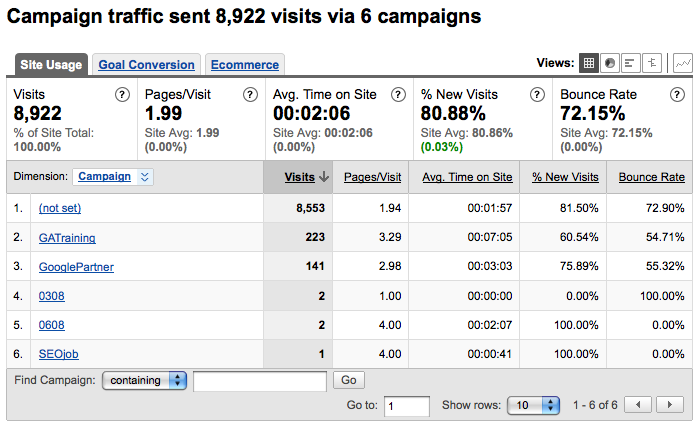Measuring Offline Advertising In Google Analytics
Google Analytics does a great job of helping you measure online advertising. Not only does it integrate with AdWords, but you can use it to measure any kind of internet marketing, such as banner ads, email marketing, etc. The Campaign reports then give you all kind of data about your marketing, like bounce rates and conversion rates by campaign, by medium, or by source.
This helps you decide where you’re being effective in spending your advertising budget and where you’re pouring money down the drain on people who never visit the site, who bounce once they do, or who never convert.
The Challenge of Offline Advertising for Your Website
But what if you have offline advertising that’s intended to drive people to your website — a brochure, a traditional newsletter, or for that matter some guy in a sandwich board you hired to parade up and down the street? You might just include the URL of your home page, because it’s easy to remember and type in. But then you don’t know anything about the connection between your advertising and how it drove someone to your site.
You could, of course, use campaign codes in your offline advertising, just like you do with online advertising. But here’s an example of a campaign-coded URL (broken across lines for clarity):
http://example.com/destination?utm_source=brochure
&utm_medium=print&utm_campaign=fall08
Remember, this is in print. So a user has to type all that in? I don’t think so.
The Solution: Vanity URLs
You need nice, short, easy-to-remember URLs in print, because someone’s going to have to type them in. So you want something like:
http://example.com/ad
or
http://ad.example.com
or even simply
http://mypromotion.com
These kind of short, catchy URLs are known as “vanity URLs.” They’re pretty names for pages that actually live somewhere on your site — maybe just your homepage, or even better, a dedicated landing page for the promotion.
So suppose your vanity URL is http://example.com/ad, and you would really like it to point to http://example.com/promotion/landingpage. (We’ll do this with a technique called “redirects” that we’ll talk about in a minute.) But if you’re already pointing your short URL at a longer URL, why not go all the way and include campaign codes? Start with
http://example.com/ad
which is nice and short and easy to type. Send it to (broken across lines for clarity)
http://example.com/promotion/landingpage?utm_source=brochure
&utm_medium=print&utm_campaign=fall08
This does two things: (1) it goes to the landing page you want, and (2) it uses campaign codes to track that this is part of your “Fall 08” campaign, the medium was “print”, and the source was “brochure.” All that will show up in your Campaign reports, right alongside your online advertising. Awesome!
How to Do It: 301 Redirects
There are a number of ways to point URL A to URL B; this is called “redirection.” I’m not going to go into gory details about different methods, but what I will say is this: the kind of redirect you want to use is called a “301 redirect.” There are lots of reasons this is better than various other ways to redirect URLs, including being good for your search engine optimization.
A 301 redirect is called “301” after the HTTP status code that is returned when a browser requests the URL. (You’re familiar with other status codes like “404” for a page that can’t be found.) All the redirect does is say “The page you were looking for at this URL? It’s at this other URL instead. Go there.#8221; And your browser automatically does.
A 301 redirect occurs on your web server. Depending on what web server you’re using and how your site is architected, there are a number of ways to accomplish this. I’m not going to cover every one in detail, but here are some links to popular ways you might accomplish this.
- If you’re using the Apache web server, you can use the mod_rewrite engine
- If you’re using the IIS web server, you can use the ISAPI_rewrite engine
- Depending on your site, you may also use a custom scripting solution for rewriting URLs, such as one based on PHP or ASP.NET
There are lots of options here, and you should think about how they fit with the way your site currently works behind the scenes, as well as how you’ll maintain the list of vanity URLs and campaign-coded destination links as you add to them in the future.
So, go ahead and start tracking your offline advertising!
-Jonathan



